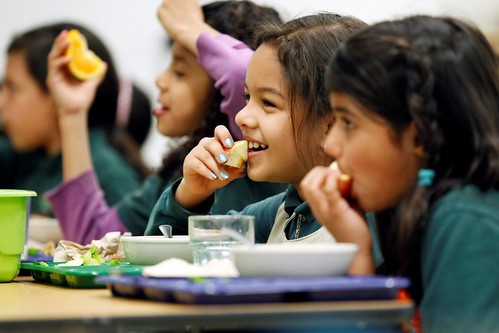
Cross posted from Secretary Vilsack's Medium page:
More than seven years ago, in one of my very first conversations with newly-elected President Obama, his charge to me was simple: “feed the children and feed them well.” Today, I’m proud to say that feeding children and supporting families in a time of great need is not only among the greatest domestic policy achievements of USDA under the Obama Administration, it is among my proudest accomplishments as Secretary.
In 2008, facing the most difficult economic downturn in decades, a growing number of Americans confronted hunger on a daily basis. The programs that form the foundation of our country’s nutrition safety net—the National School Lunch Program and School Breakfast Program, the Supplemental Nutrition Assistance Program (SNAP) and the Special Supplemental Nutrition Program for Women, Infants and Children (WIC)—were in need of unwavering commitment to improve access for all people as well as consistent and strategic investment to ensure healthy foods were available to every participant. At the same time, an obesity epidemic, hunger’s twin, had gripped America’s children and many pointed to outdated school meal standards that distressed physicians, parents and teachers.
Seven years later, food insecurity, including the prevalence of hunger among children, has steadily declined from its peak in 2011. Data shows that obesity rates are falling among young kids due in part to the nutritional improvements made to WIC. Our core USDA nutrition assistance programs are reaching more people in need. The National School Lunch Program has experienced a 19 percent increase in free and reduced price lunch participation, while participation in the School Breakfast Program has increased by 30 percent, suggesting more low-income children are benefiting from these programs. Participation in USDA’s Child and Adult Care Food Program has increased by 15 percent, helping to feed nearly 3 million kids each day. Nearly 4 million children have access to healthy food in the summer when school is out and meals are scarce. In addition to that, 8 million low-income women, infants and young children now receive an improved variety of healthy food in WIC food packages thanks to changes implemented by this Administration.
Significant strides have also been made to help economically-dislocated Americans return to work with job training and placement. We replaced an outdated Food Pyramid with MyPlate—an easy and practical nutrition guide that illustrates the five food groups needed to help build a healthy diet. And because of changes made under the historic Healthy, Hunger-Free Kids Act of 2010, over 50 million children have a healthier food environment at school.
Today, we’ve published the first half of the story of how that historic progress came to be. Under the consistent direction of thoughtful leaders like Administrator Audrey Rowe, former Deputy Under Secretary Dr. Janey Thornton, my longtime friend and advisor Under Secretary Kevin Concannon, and the whole team at USDA’s Food and Nutrition Consumer Services (FNCS), we have made great strides during this Administration to maximize the ability of our programs to fight hunger and improve health for more children and families. Their sound leadership has guided us to focus on science-based food and nutrition strategies that contribute to our country’s national and economic security. We’ve built strong and lasting partnerships with schools, helping them to implement historic new standards designed to improve the quality of food served and sold in schools across the country. And we’ve improved access while strengthening the integrity of all USDA nutrition programs.
Please take some time to explore Part I of our two-part series on Growing a Healthier Future. And stay tuned for Part II next week.
We know that important work remains to reduce food insecurity and poverty and continue to improve access to healthy, affordable food. So, let’s examine the results of our work since 2008 that’s helping us build a healthier next generation.


